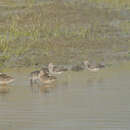fr
noms dans le fil d’Ariane


Named for its long, thin legs, the Stilt Sandpiper (8 1/2 inches) appears to most North American birders as a grayish wader with a white breast, light gray neck, and long white eye-stripes. However, this species’ breeding plumage gives it a brown-scalloped breast and rusty-red cheek patch. In all plumages, the Stilt Sandpiper may be separated from other related species by its tall stature. Males and females are similar at all seasons. The Stilt Sandpiper winters locally along the arctic coast of North America from the Hudson Bay to northern Alaska. This species is a long-distance migrant, wintering primarily in south-central South America. However, smaller wintering populations exist further north, including in central Mexico, along the western Gulf coast, and locally in Florida and South Carolina. The Stilt Sandpiper breeds on wet tundra. On migration and during the winter, this species may be found along the edges of ponds and in shallow coastal lagoons and mudflats. Stilt Sandpipers primarily consume small invertebrates, particularly insects and larvae. Due to its remote breeding habitat, most birdwatchers never see the Stilt Sandpiper during the summer. On migration or during the winter, this species may be seen probing the mud for food with its bill while wading in shallow water. The Stilt Sandpiper is primarily active during the day.
Calidris himantopus
Le Bécasseau à échasses ou Bécasseau échasse (Calidris himantopus) est une espèce d'oiseaux limicoles appartenant à la famille des Scolopacidae.
Ce bécasseau mesure de 18 à 23 cm de longueur.
Calidris himantopus
Le Bécasseau à échasses ou Bécasseau échasse (Calidris himantopus) est une espèce d'oiseaux limicoles appartenant à la famille des Scolopacidae.